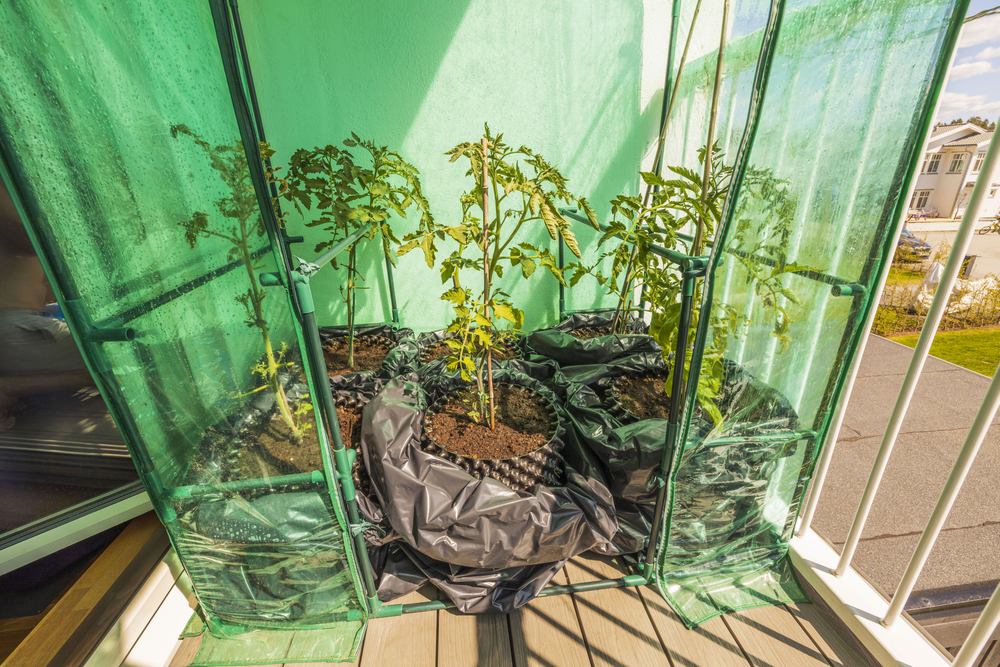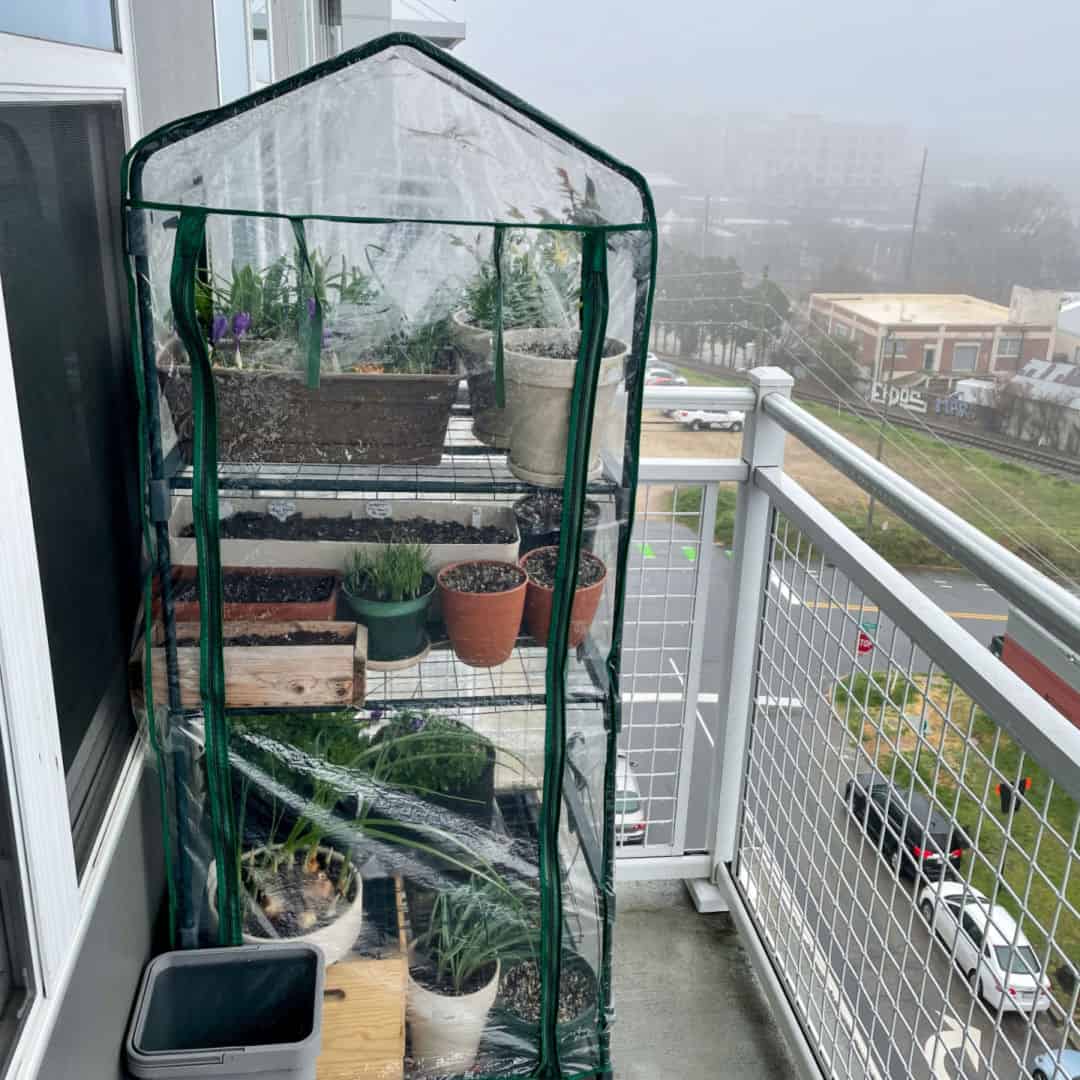A balcony greenhouse can be a useful addition to your plant-keeping kit. Of course, working in a confined space like a balcony does mean some restrictions when compared to buying a greenhouse for a backyard.
Even so, picking an appropriate model follows many of the same considerations. In this article, we’ll cover these, so you can pick out the best apartment balcony greenhouse for your plants.
Why Buy a Balcony Greenhouse?
A greenhouse primarily controls the climate for the plants inside it. You’d do this for the following reasons:
- Germinating seeds
- Growing plants that might not suit your local climate
- Overwintering plants
- Protecting plants from pests
Pretty much all greenhouses will be capable of providing these benefits, although some are better at certain tasks than others. This comes down to what material is used, but the differences are fairly minor.
Considerations Before Buying an Apartment Balcony Greenhouse

A balcony greenhouse might not seem like a difficult thing to buy, but there are some things to think about first. Here are the most important considerations:
Size
It might seem obvious, but size is a good place to start. After all, you probably don’t want a greenhouse that takes up your whole balcony.
If your main goal is to germinate seedlings and root propagations, you can get away with a much smaller balcony greenhouse. But if you’re using it to overwinter plants, it’ll obviously need to be as big as your largest plant.
How Often Do You Need it?
Plenty of balcony greenhouses are temporary structures, meaning you can take them down and store them when not in use. Of course, this isn’t usually an option with glass, which is a permanent structure.
If you only plan to use it seasonally, find a greenhouse that’s easy to store. There are plenty of these options available, as we’ll discuss below.
But if you want a year-round greenhouse, you’ve got a lot more freedom. You could still use collapsible options, but you could also look at sturdier ones made from wood and glass.
Material
When choosing a balcony greenhouse, you must think about the materials used for both the transparent panes and the structure. Here’s a quick roundup of the most common options.
Glass
Glass is probably what comes to mind when you think of a greenhouse. It lets in up to 90% of sunlight while also blocking UV radiation (which plants don’t need). However, it can be expensive and is obviously fragile. It’s good for permanent structures but is prone to damage.
Polyethylene or PVC
These options are essentially the same: they’re flexible plastic that you’d find in collapsible greenhouses or polytunnels. They’re typically less transparent than glass and don’t have as much UV resistance.
They’re the least expensive materials for a balcony greenhouse but have a limited lifespan because they can be damaged by UV radiation. Some products have UV resistance, but they’ll cost more.
Polycarbonate
Polycarbonate is somewhere in the middle. It’s a rigid plastic that’s similar to glass, just much cheaper. It provides excellent thermal protection and blocks up to 99% of UV radiation. You’ll find single or twin wall polycarbonate greenhouses.
Structure Materials
Generally, the structure of a greenhouse will be made out of the following materials:
- Wood – only remains weather resistant if treated.
- PVC – inexpensive but has a limited lifespan.
- Steel – strong and durable but will eventually oxidize (unless stainless).
- Aluminum – expensive but very weather-resistant.
Temporary greenhouses will typically be plastic with a bit of steel or aluminum mixed in. This is fine if you don’t keep them up all year, but for permanent structures, choose a material that suits your climate.
Types of Balcony Greenhouse
Now that we’ve got an idea about materials and purposes, let’s look at the different types of apartment balcony greenhouse that are available.
1. Seed Propagator
A seed propagator (like this one) is basically a tiny greenhouse that, unsurprisingly, is used to germinate seeds. They’re never very big, but they’re ideal for setting up some seedlings. There are also options (like this one) that are basically seedling trays with lids.
Pros
- Ideal for germinating seeds.
- Inexpensive.
- Plenty of extra features – air vents, watering options, etc.
Cons
- Aren’t great for anything other than small plants.
2. Mini Greenhouse
A mini greenhouse (like this one) is pretty much perfect for a balcony where space is limited. The outer layer is usually made from PVC or another flexible plastic, which also makes them easy to store. Something like this would be suitable for overwintering small plants or setting up an herb garden.
Pros
- Compact.
- Easy to store.
- Typically inexpensive.
Cons
- Won’t provide great thermal insulation.
3. Pop Up Greenhouse
Another great option for balconies is a pop-up greenhouse (like this one). Its biggest advantage is that it’s easy to store, so it’d be ideal for temporary use. Unlike the mini greenhouse, it’s much bigger, meaning you could have decent-sized plants in it.
Pros
- Designed for easy storage.
- Can be pegged down for stability.
- Plenty of room inside.
Cons
- UV resistance not as good as glass.
4. Lean-To Greenhouse
A lean-to greenhouse (like this one) is built against an existing wall. While this does sacrifice some space compared to a full walk-in greenhouse, it’s a good compromise for balconies. Plus, with a more permanent option like this, you can start looking at superior materials, such as polycarbonate and plastic.
Pros
- Better transparent materials.
- Space-saving permanent option.
- More durable than fold-up greenhouses.
Cons
- More expensive.
5. DIY Greenhouse
If you’ve got some spare time (and DIY skills), it’s possible to build your own balcony greenhouse. Using materials such as polyethylene film, you’d just need to build a simple frame for it. We won’t go into too much detail here because we have a whole article on DIY greenhouses.
Final Thoughts on Balcony Greenhouses
There you have it: everything you could need to know about a balcony greenhouse. Hopefully, using this guide, you should be able to pick out an option that’s perfect for your plants. Happy growing!
